Lesser Whistling Duck
|
There's so much variety of birds in Keoladeo National Park that I can go on and on about the sheer variety of birds we saw there. It was certainly a joy and a learning experience. One activity that I did before we went to Bharatpur that helped us sight and identify birds during our trip was that we went through the website List of Birds at Keoladeo National Park and marked them in our copy of A Pictorial Field Guide to Birds of India. We also read a bit about these birds. This ensured that these birds were on the top of our mind when we visited Bharatpur and we could quickly mark them in our list. If you are planning to visit a place like Keoladeo National Park, it is recommended that you do some research before you head there so that you can make the most of your trip.
 |
| White-throated Kingfisher |
We have already talked about Herons, Egrets, and Bitterns and also about Storks and Cranes that we saw at keoladeo National Park. In this post, we will talk about all other waterbirds we sighted here. Let's start with one of the most common waterbirds, except cattle egret of course, that we can see around us even in urban areas. It is the White-throated Kingfisher. This beautiful bird is often found solitary, sitting on overhead power lines close to waterbodies in cities. We saw several of these birds in Keoladeo National Park, but only a couple were close enough to be clicked.
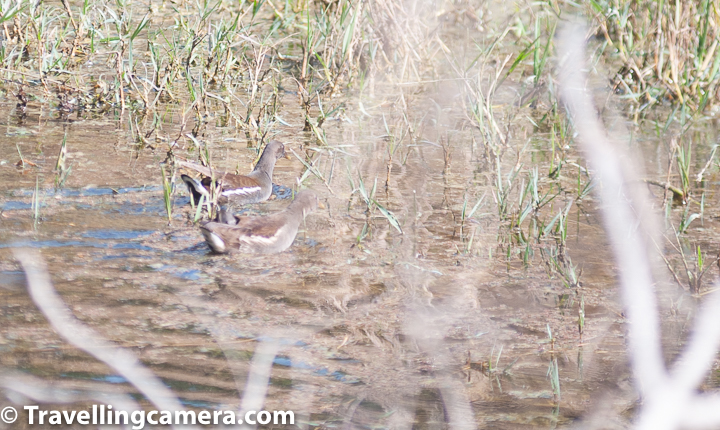 |
| Common Moorhen (Juvenile) |
Another waterbird that we saw almost as soon as we reached the wetlands was the Moorhen, a very common member of the rail family. In the above picture, you can see a couple of Juveniles swimming around. I first thought that these were females, however, upon reading further I found that males and females are almost indistinguishable in Moorhens. It is the juveniles that have brownish plumage. Full grown moorhens have deep brown wings with an almost black neck and body.
 |
| Common Moorhen - full grown |
You can see full-grown moorhens in the above photograph. Another interesting fact about Moorhens is that the males of this species is also known as a moorhen and not a moorcock. A moorcock is a completely different bird. Moorhens usually form a monogamous pair and are territorial while breeding. Each pair builds several nests in its territory and each nest may contain 4-12 eggs, laid at the rate of one egg per day.
 |
| Common Sandpiper |
Very close to the colony of Moorhens, we spotted this lone Common Sandpiper on a bark close to the waterbody. This is unusual because these are gregarious birds and are often seen in large flocks. The bird feeds on worms and molluscs and may even catch insects during flight. This was one of the few migratory birds that we saw at Bharatpur.
 |
| Common Coot |
Common Coot was another migratory bird that we saw at Keoladeo National Park. This duck-like member of the rail family is also as territorial as the Moorhen, and more so during the breeding season. When not breeding, these birds form large flocks to stay safe. Common Coots do not make good parents when there is scarcity of food, because in such conditions, Common Coots bite their babies that beg for food to keep them quite. Sometimes babies may end up being killed because of this.
 |
| Common Coot |
Both male and female Common Coots look alike, They are almost completely black with the exception of a white shield on their forehead and beak. The black is less pronounced in younger birds and they also lack the white shield. The black plumage develops at around 4-5 month of age. Both make and females are aggressive when it comes to protecting their nests and, when compared to other members of rail family, are less shy.
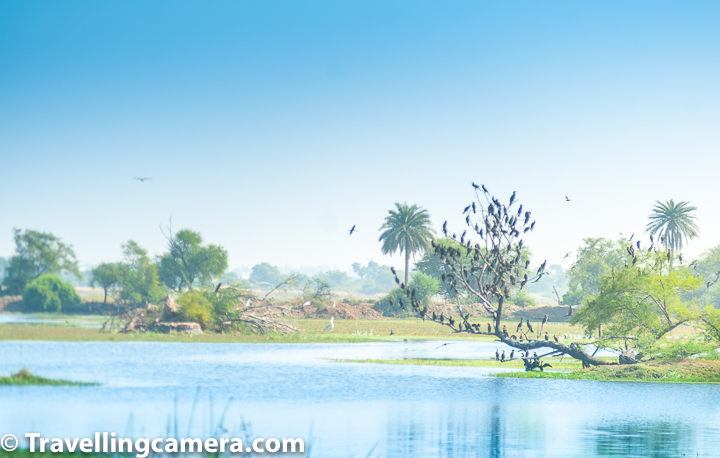 |
| Cormorants |
Cormorants are a common sight in almost all wetlands and are excellent divers. They use their webbed feet and wings to propel themselves when under water. They feed mostly on fish and have adapted to both saltwater and freshwater habitats. Keoladeo is home to Little Cormorant, Indian Cormorant, and Great Cormorant, and we were lucky enough to spot all. We will talk about the differences between these three types of cormorant a little later.
 |
| Lesser Whistling Duck |
The Lesser Whistling Duck is also known as the Indian Whistling Duck, and are common aquatic birds in the Indian Subcontinent and South-East Asia. These birds usually feed during the night and can be found sunning themselves during the day. They sleep while standing, their neck curled to keep the sun away from their eyes. Males and Females are are alike in appearance. These ducks are resident at the Keoladeo National Park.
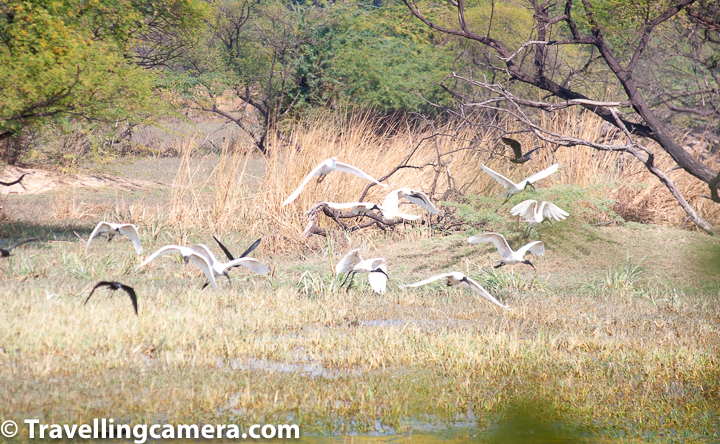 |
| Ibises - Black-headed and Glossy |
We saw two types of Ibises at the Keoladeo National Park. Of them, the black-headed Ibis is the resident species. It is often confused with the white Ibis though its black neck and beak stand in stark contrast with its overall white plumage. Male and female are identical. During the breeding season, some Ibises may develop a black tuft of feathers on the tail. Ibises have adapted themselves to both natural and manmade waterbodies and are highly versatile.
 |
| Lesser Whistling Ducks in the foreground, Ibises in the back |
The Glossy Ibis is a migrant species at the Keoladeo National Park. It can be seen keeping company with the black-headed Ibises, and is often mistaken as a black Ibis. It is a highly nomadic bird and birds may disperse after breeding. They feast mostly on aquatic insects and crustaceans and occasionally also on fish, lizards and other small aquatic animals. Aquatic birds are often seen in close company with different types of birds. In the above photograph, you can see black-headed and Glossy Ibises in company with Lesser Whistling Ducks and even a couple of egrets.
 |
| Little Cormorant |
This bird with almost entirely black body is the little cormorant. It is slightly smaller than the Indian Cormorant and mostly forages alone or in loose groups of a few individuals. Unlike the Indian Cormorant, the little cormorant lacks a pointed head profile. The little cormorant is found in India, Bangladesh, Srilanka, Pakistan and Nepal. It is not found in the Himalayas though some solitary individuals have been sighted in Ladakh.
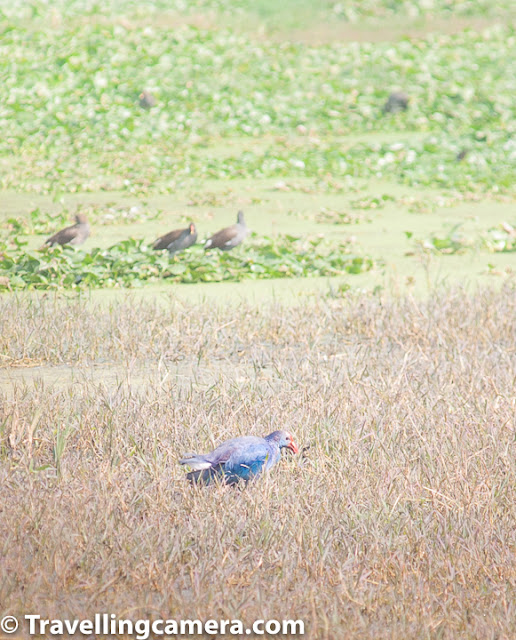 |
| Grey-headed Swamphen in the foreground; Common moorhens in the back |
This bird was earlier known as the Purple Swamphen, but the species has now been subdivided into 6 species, among them the Grey-headed Swamphen, which is found in the Indian Subcontinent. Now the Purple Swamphen is considered as a superspecies, whereas the each of the 6 sub-divisions have been elevated to the status of a full species. The male has an elaborate courtship display where it bobs up and down all the while holding weeds in its beak. It would be interesting to watch I am sure. But we were not so lucky.
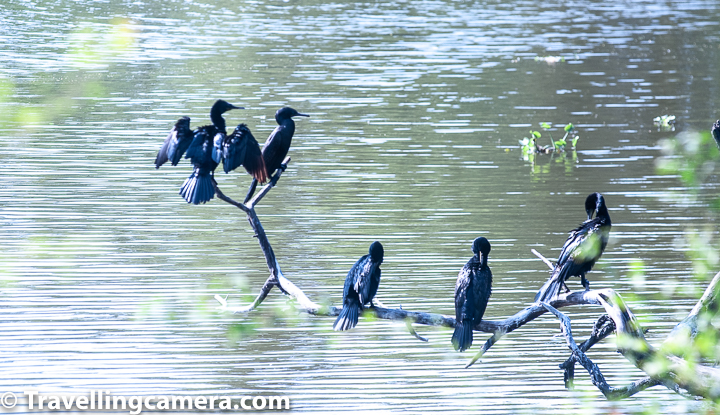 |
| Great Cormorants |
The Great Cormorants are big birds, but their sizes may vary greatly depending upon the region they are from. These birds can be seen perched on trees around waterbodies in large groups. These birds have adapted themselves to a wide variety of habitats including saltwater and freshwater wetlands. Great Cormorants indulge in long-term pairing and one pair may continue to use the same nest year-after-year.
 |
| Oriental Darter |
Oriental Darter bird is also known as the Snake Bird because of its long thin neck and the way it appears when it dives and swims in the water. Oriental Darter hunts with its body submerged and only the neck visible above the water. It spears the fish with this pointed beak and then brings it on the surface. It is often seen on rocks on the edges of wetlands, with its wings spread, sunning itself.
 |
| Indian Cormorant |
The Indian Cormorant is also known as the Indian Shag and is mostly found in Indian Subcontinent. It is a mid-size cormorant which has a dark copper brown plumage. It has a long narrow beak that ends in a hook. Its head is slightly domed and the eye is blue. Male and Female Indian Cormorants are similar, but juveniles and non-breeding adults are lighter brown than the breeding individuals.
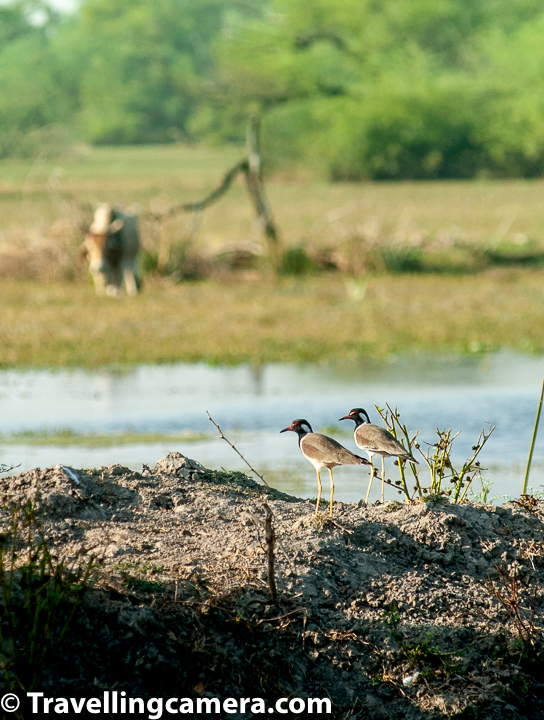 |
| Red-Wattled Lapwing |
The Red-Wattled Lapwing is a large plover that is commonly seen and heard in urban habitats as well. It's call that sounds like did-he-do-it can be heard commonly during the day and night. This is an alarm call that warns about the presence of humans or animals around. These birds are incapable of perching and are mostly seen on ground. Their chicks immediately after hatching start following the adults around for feeding.
There are so many birds that we saw but could not click at Keoladeo National Park. And there were so many beautiful scenes of peaceful co-habitation among species that we found difficult to express through photographs. We saw feral cattle driving away herons and storks, but then simply letting them be. It looked like a giant playground for these different animals. But appearances are often deceptive and we know that the ultimate question is of survival. There is violence beneath the surface, and that is the reality, whether we like it or not.


.jpg)
Comments